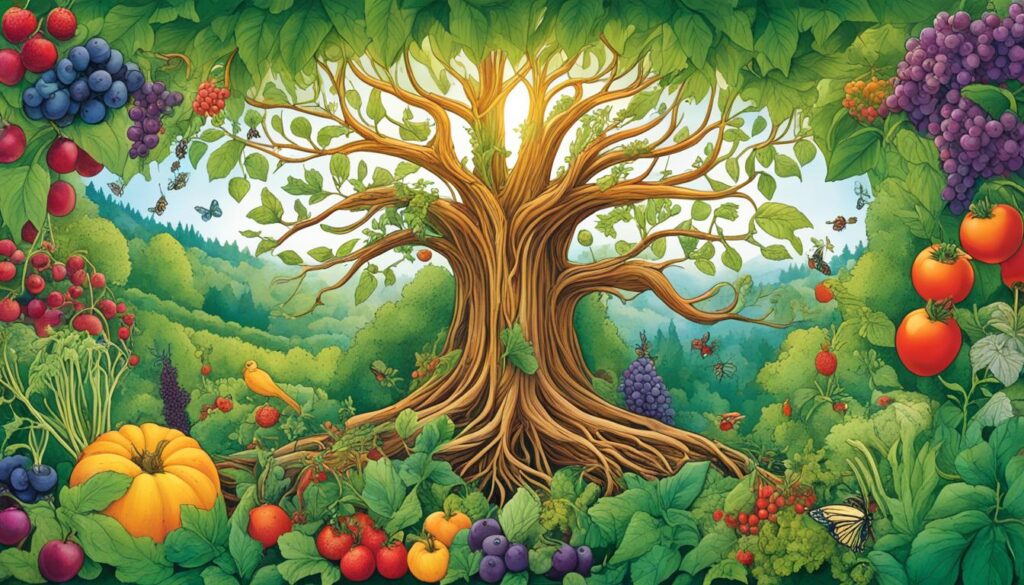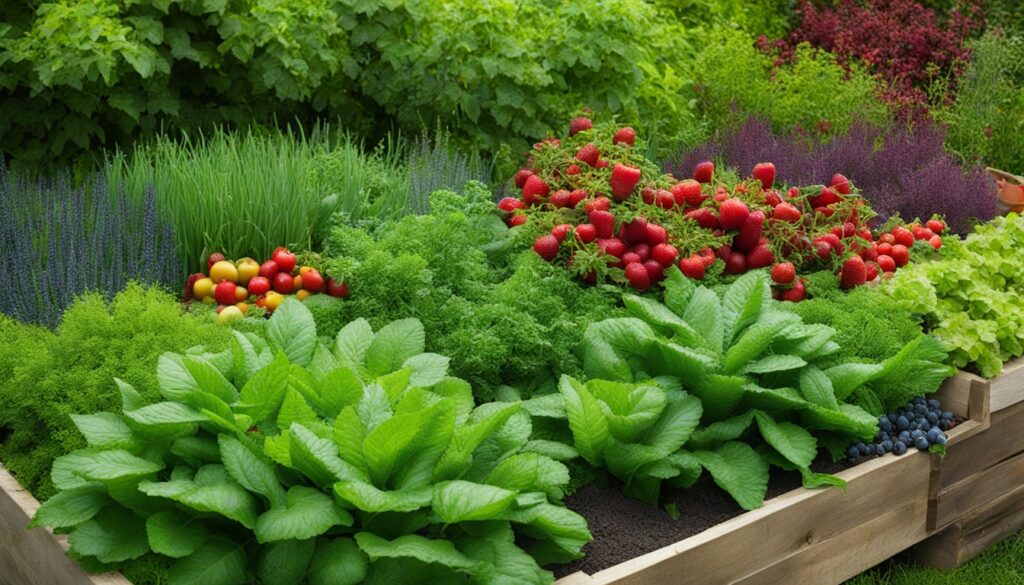Creating a food forest is a great way to grow food forest plants that help the planet and its creatures. It’s about making a garden that has many layers, like nature does. This way, you get lots of food and help the environment.
It’s important to pick the right plants for your food forest. You need a mix of annuals, perennials, and trees. This mix makes your garden full of life and variety.
Many people think they have a few plants in their yards, but they’re often wrong. They might guess 10 to 20 species, but there could be many more. This shows how much life is hiding in plain sight.
When planning your garden, think about plants that taste great and help nature. This makes your garden better for you and the local wildlife. It also helps make your garden last for years to come.
For more tips on making your garden healthier, check out this useful guide.
The Importance of Biodiversity in Food Forests
Biodiversity is key to making food forests strong. Having many plant types helps them fight pests and diseases. This makes them less dependent on chemicals. It also helps with soil health and saving water.
Adding different plants brings in various animals. This helps pollinators and other good creatures. In one study, 30 yards had almost 700 types of plants. More than half were native, showing how local areas can help biodiversity.
As the world faces a big loss of biodiversity, food forests are more important. Using regenerative farming helps the environment and gives us food. This way, we meet our needs and help wildlife, making a better world for all.

Choosing the Right Trees for Your Food Forest
Choosing the right trees is key to a thriving food forest. Think about the climate, soil, and what you want the trees for. This could be for fruits, nuts, or shade. Grouping trees by height and role helps them grow well together, making a healthy home for many species.
Using local and native trees helps the local ecosystem. They need less care because they fit right in. By planting different trees together, you use space better and help the whole area stay healthy.

| Tree Type | Climate Adaptability | Benefits |
|---|---|---|
| Fruit Trees | Varies by species (e.g., apples in temperate) | Produces food, attracts pollinators |
| Nitrogen-Fixing Trees | Tropical and subtropical regions | Enhances soil fertility |
| Nuts | Varies (e.g., walnuts in cooler climates) | High-energy food source, long-term investment |
By picking a mix of tree species, you help create a balanced ecosystem. This supports both wildlife and farming, making your food forest sustainable.
What plants are good for food forests?
Creating a sustainable food forest means picking different plants for a rich ecosystem. You should include fruit trees, nuts, and nitrogen-fixing trees. Each plant has its own role in making your garden more productive and healthy.
Common Fruit Trees to Consider
For fruit trees, think about apples, pears, and plums. These trees give you fruit and help other plants grow under them. Having different types of the same fruit tree helps with pollination, making more fruit.
Nuts as Valuable Food Sources
Nut trees like pecans and hazelnuts are great for your food forest. They give you food and make the soil better with their roots. Adding these nuts makes your harvest more valuable and helps your food forest last longer.
Choosing Nitrogen-Fixing Trees
Choosing trees that fix nitrogen like black locust and alder is key for healthy soil. These trees make the soil richer with nitrogen. Adding them helps your food forest grow strong and supports many plants.

Understory Plants: Herbs and Vegetables
The understory layer is key in edible forest gardening. It lets you grow many herbs and vegetables. These understory plants love the shade under big trees. They make your food forest better and help with nature.
Common perennial herbs include:
- Parsley
- Chives
- Nasturtium – known for its vibrant flowers that attract beneficial insects
Lettuce and spinach grow well in the shade of trees. Adding these understory plants boosts your garden’s food yield. It also helps with pest control and plant health.
Choosing the right understory plants makes your garden work well for food and nature. Working with these garden layers helps you get the most from your garden. Enjoy the benefits of your hard work.
Ground Covers: Maximizing Space and Resources
Ground covers are key in food forests. They offer many benefits and make the ecosystem better. Plants like creeping thyme and clover are great choices. They use space well, stop soil erosion, and keep weeds away.
Benefits of Planting Creeping Thyme
Creeping thyme is a top pick for covering the ground. It’s tough and stops soil from washing away. It also keeps weeds down and draws in pollinators.
Its small size lets it spread out and fill big areas. This keeps the soil covered and healthy.
Using Clover as a Beneficial Ground Cover
Clover is another great choice for ground cover. It fixes nitrogen in the soil and helps insects. It keeps the soil moist, so you water less.
Its thick growth keeps the soil cool and stops weeds. It’s perfect for making the most of your garden space.
Incorporating Perennial Food Crops
Adding perennial food crops to your garden makes it more sustainable and cuts down on work. Plants like asparagus, rhubarb, and berries grow for years and help the soil get healthier. This way, you get more food and better soil over time. It’s all about sustainable agriculture and lasting productivity.
Using perennials means you plant less often, saving you time. They grow well in different weather, making your garden stronger against bad weather. By picking the right plants together, you create a balanced garden that feeds itself and keeps pests away.
For instance, planting daffodils and garlic with fruit trees helps keep grass down, brings in bees, and keeps pests away. This not only helps the main crop but also makes a healthy garden community. Watch your garden and change things as needed to keep it healthy and productive.
Creating a food forest with perennial food crops is key to a low-maintenance, high-yield garden. Pick the right plants and see which ones work best together for a successful garden. This leads to a sustainable and rewarding gardening future.
For more tips on plants that help your garden, check out this resource.
Understanding Companion Planting in Food Forests
Companion planting is key in sustainable farming, especially in food forests. It means pairing plants to help each other grow better, taste better, and keep pests away. About 52% of food forests use this method to increase diversity and productivity.
Complementary Species for Pest Control
Companion planting helps create a natural way to fight pests. Some plants protect each other from harmful insects. For example, marigolds keep nematodes away, making crops healthier.
Legume plants are in 70% of food forests. They fix nitrogen, attract pollinators, and bring in pest predators. This helps create a balanced ecosystem where good bugs help your crops.
Enhancing Flavor and Growth Through Companions
Companion planting also makes plants taste and grow better. Basil with tomatoes tastes great together. This combo makes tomatoes taste better.
Perennial vegetables are in 55% of food forests. They help plants grow well with the right companions. Using different plants together makes a healthy, productive food forest.
Forest Gardening Techniques for Sustainable Practices
Forest gardening uses methods that help the environment and grow food. It’s all about making your garden better for nature and for you. By planting in layers, you use space well and bring more life to your garden.
Layering means planting big trees, shrubs, and smaller plants together. This saves space and helps plants work well with each other. Using many types of plants together makes your garden strong against pests.
Other great ways to garden include:
- Mulching: This keeps the soil moist and full of nutrients, helping plants grow strong.
- Cover cropping: Cover crops add good stuff to the soil, making it richer and healthier.
- Companion planting: Growing certain plants together makes them grow better and fight off pests.
These methods make your garden work better and help the planet. They keep your garden healthy and support nature. By using these ideas, you’re helping the soil and making your garden last longer.
Maintenance Tips for Thriving Food Forests
To keep your food forest healthy, regular care is key. Start by trimming trees to let sunlight in and air move freely. This helps your plants stay healthy.
Also, use mulch to keep soil moist and stop weeds from growing. This means your plants get more of what they need to thrive. Add these tips to your routine for a healthy, sustainable garden.
Watch out for pests and diseases in your food forest. Catching problems early helps keep your plants productive. Rotating crops helps the soil too. It lowers disease risk and makes nutrients more available.
Always have a plan for soil health. Use organic stuff and nutrients to keep your soil good for years to come.
Remember, fruit trees take a while to grow and produce fruit. But, grafting can make them produce faster. Use these tips, and you’ll have a lively, productive food forest. It will follow the rules of sustainable farming.



